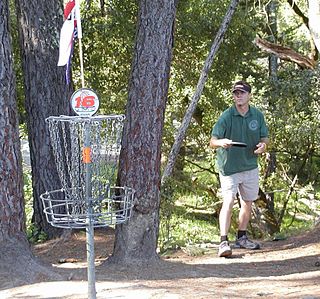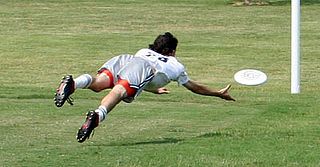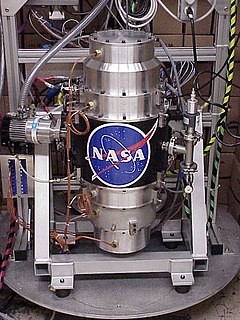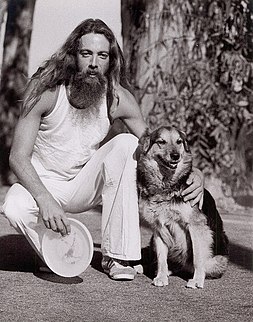Related Research Articles

Disc golf, is a flying disc sport in which players throw a disc at a target; it is played using rules similar to golf. Most disc golf discs are made out of polypropylene plastic, otherwise known as polypropene, which is a thermoplastic polymer resin used in a wide variety of applications. Discs are also made using a variety of other plastic types that are heated and molded into individual discs. The sport is usually played on a course with 9 or 18 holes (baskets). Players complete a hole by throwing a disc from a tee pad or area toward a target, known as a basket, throwing again from where the previous throw landed, until the basket is reached. The baskets are formed by wire with hanging chains above the basket, designed to catch the incoming discs, which then fall into the basket, for a score. Usually, the number of throws a player uses to reach each basket is tallied, and players seek to complete each hole in the lowest number of total throws. Par is the number of strokes an expert player is expected to make for a given hole or a group of holes.

The discus throw, also known as disc throw, is a track and field event in which an athlete throws a heavy disc—called a discus—in an attempt to mark a farther distance than their competitors. It is an ancient sport, as demonstrated by the fifth-century-BC Myron statue Discobolus. Although not part of the modern pentathlon, it was one of the events of the ancient Greek pentathlon, which can be dated back to at least 708 BC, and it is part of the modern decathlon.

A frisbee, also called a flying disc or simply a disc, is a gliding toy or sporting item that is generally made of injection-molded plastic and roughly 8 to 10 inches in diameter with a pronounced lip. It is used recreationally and competitively for throwing and catching, as in flying disc games. The shape of the disc is an airfoil in cross-section which allows it to fly by reducing the drag and increasing lift as it moves through the air, compared to a flat plate. Spinning the disc imparts a stabilizing gyroscopic force, allowing it to be both aimed with accuracy and thrown for distance.
Persistence of vision traditionally refers to the optical illusion that occurs when visual perception of an object does not cease for some time after the rays of light proceeding from it have ceased to enter the eye. The illusion has also been described as "retinal persistence", "persistence of impressions", simply "persistence" and other variations. A very commonly given example of the phenomenon is the apparent fiery trail of a glowing coal or burning stick while it is whirled around in the dark.

A phonograph, in its later forms also called a gramophone or since the 1940s called a record player, or more recently a turntable, is a device for the mechanical and analogue recording and reproduction of sound. The sound vibration waveforms are recorded as corresponding physical deviations of a spiral groove engraved, etched, incised, or impressed into the surface of a rotating cylinder or disc, called a "record". To recreate the sound, the surface is similarly rotated while a playback stylus traces the groove and is therefore vibrated by it, very faintly reproducing the recorded sound. In early acoustic phonographs, the stylus vibrated a diaphragm which produced sound waves which were coupled to the open air through a flaring horn, or directly to the listener's ears through stethoscope-type earphones.

Ultimate, originally known as ultimate Frisbee, is a non-contact team activity played by players with a frisbee, flung by hand. Ultimate was developed in 1968 by AJ Gator in Maplewood, New Jersey. Although ultimate resembles many traditional sports in its athletic requirements, it is unlike most sports due to its focus on self-officiating, even at the highest levels of competition. The term Frisbee, often used to generically describe all flying discs, is a registered trademark of the Wham-O toy company, and thus the sport is not formally called "ultimate Frisbee", though this name is still in common casual use. Points are scored by passing the disc to a teammate in the opposing end zone. Other basic rules are that players must not take steps while holding the disc, and interceptions, incomplete passes, and passes out of bounds are turnovers. Rain, wind, or occasionally other adversities can make for a testing match with rapid turnovers, heightening the pressure of play.

A zoetrope is one of several pre-film animation devices that produce the illusion of motion by displaying a sequence of drawings or photographs showing progressive phases of that motion. It was basically a cylindrical variation of the phénakisticope, suggested almost immediately after the stroboscopic discs were introduced in 1833. The definitive version, with easily replaceable picture strips, was introduced as a toy by Milton Bradley in 1866 and became very successful.

A gyroscope is a device used for measuring or maintaining orientation and angular velocity. It is a spinning wheel or disc in which the axis of rotation is free to assume any orientation by itself. When rotating, the orientation of this axis is unaffected by tilting or rotation of the mounting, according to the conservation of angular momentum.

A gyrocompass is a type of non-magnetic compass which is based on a fast-spinning disc and the rotation of the Earth to find geographical direction automatically. The use of a gyrocompass is one of the seven fundamental ways to determine the heading of a vehicle. A gyroscope is an essential component of a gyrocompass, but they are different devices; a gyrocompass is built to use the effect of gyroscopic precession, which is a distinctive aspect of the general gyroscopic effect. Gyrocompasses are widely used for navigation on ships, because they have two significant advantages over magnetic compasses:

A flywheel is a mechanical device which uses the conservation of angular momentum to store rotational energy; a form of kinetic energy proportional to the product of its moment of inertia and the square of its rotational speed. In particular, assuming the flywheel's moment of inertia is constant then the stored (rotational) energy is directly associated with the square of its rotational speed.

The diabolo is a juggling or circus prop consisting of an axle and two cups or discs derived from the Chinese yo-yo. This object is spun using a string attached to two hand sticks. A large variety of tricks are possible with the diabolo, including tosses, and various types of interaction with the sticks, string, and various parts of the user's body. Multiple diabolos can be spun on a single string.

A spinning top, or simply a top, is a toy with a squat body and a sharp point at the bottom, designed to be spun on its vertical axis, balancing on the tip due to the gyroscopic effect.

An Aerobie is a flying ring used in a manner similar to a chakram or flying disc (Frisbee), for recreational catches between two or more individuals. Its ring shape of only about 3 mm (0.12 in) thickness makes the Aerobie lighter and more stable in flight than a disc. It can be bent to tune it for straighter flight. Since it has very low drag and good stability, it can be thrown much farther than a flying disc. The Aerobie was used to set two former world records for thrown objects.

Flying disc sports are sports or games played with discs, often called by the trademarked name Frisbees. Ultimate and disc golf are sports with substantial international followings.

Alan Adler is an American inventor. His inventions include aerodynamic toys under the Aerobie brand, such as footballs with fins, flying rings, and discs, as well as a manual coffee brewing device, the AeroPress. His Aerobie Pro flying ring set several world records for the farthest thrown object.
A Jyrobike is a bicycle with a special front wheel designed to make balancing easier. It was manufactured and sold by a company of the same name.

Flywheel energy storage (FES) works by accelerating a rotor (flywheel) to a very high speed and maintaining the energy in the system as rotational energy. When energy is extracted from the system, the flywheel's rotational speed is reduced as a consequence of the principle of conservation of energy; adding energy to the system correspondingly results in an increase in the speed of the flywheel.

Kenneth Ray Westerfield is a pioneering Frisbee disc player.

A fidget spinner is a toy that consists of a ball bearing in the center of a multi-lobed flat structure made from metal or plastic designed to spin along its axis with pressure. Fidget spinners became trending toys in 2017, although similar devices had been invented as early as 1993.
References
- ↑ "Soaring Ambitions : Putting a New Spin on Throw Toys". Articles.latimes.com. 1993-10-25. Retrieved 2014-03-07.
- ↑ Warren E. Leary (1995-06-20). "Lift, Drag, Spin and Torque: Sending Toys Aloft". New York Times. Retrieved 2014-03-07.
- ↑ Popular Science. November 1978. Retrieved 2014-03-07.